 Technology peripherals
Technology peripherals
 AI
AI
 The robot learned to spin pens and plate walnuts! GPT-4 blessing, the more complex the task, the better the performance
The robot learned to spin pens and plate walnuts! GPT-4 blessing, the more complex the task, the better the performance
The robot learned to spin pens and plate walnuts! GPT-4 blessing, the more complex the task, the better the performance

produced by Big Data Digest
Family friends, after artificial intelligence (AI) conquered chess, Go, and Dota, I am writing this article This skill has also been learned by AI robots.
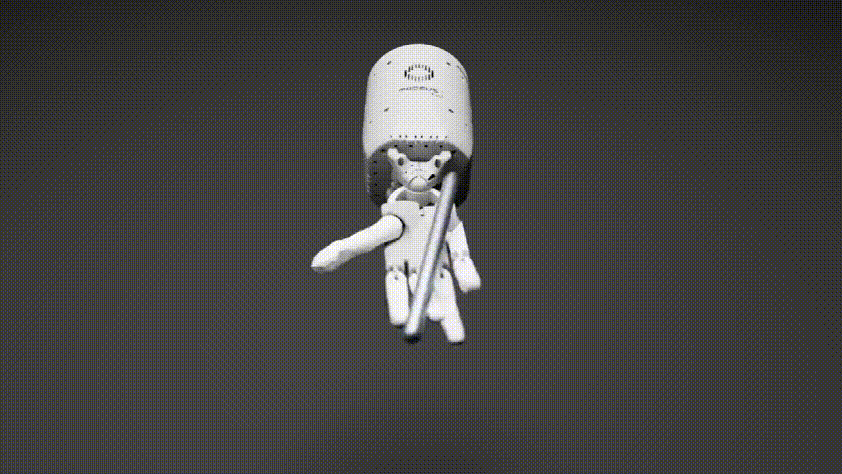
The above-mentioned pen-turning robot benefits from an agent called Eureka, which comes from NVIDIA and the University of Pennsylvania. , a study from Caltech and the University of Texas at Austin.
After receiving Eureka's "guidance", the robot can also open drawers and cabinets, throw and catch balls, or use scissors. According to Nvidia, Eureka comes in 10 different types and can perform 29 different tasks.
You must know that in the past, the function of pen transfer could not be realized so smoothly by manual programming by human experts.
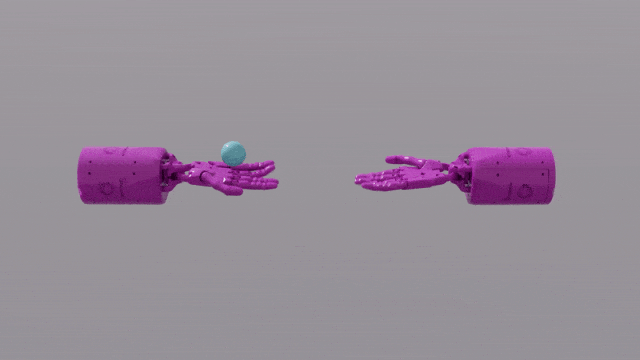
Robot Panwalnut
And Eureka can independently write reward algorithms to train robots, and has the coding power Powerful: The self-written reward program surpasses human experts in 83% of tasks, improving the robot's performance by an average of 52%.
Eureka has created a new way of learning without gradient from human feedback. It can easily absorb rewards and text feedback provided by humans, thereby further improving its own reward generation mechanism.
Specifically, Eureka leverages OpenAI’s GPT-4 to write reward programs for trial-and-error learning of robots. This means that the system does not rely on human task-specific cues or preset reward patterns.
Eureka can quickly evaluate the merits of a large number of candidate rewards by using GPU-accelerated simulation in Isaac Gym, allowing for more efficient training. Eureka then generates a summary of key statistics of the training results and guides the LLM (Language Model) to improve the generation of the reward function. In this way, the AI agent is able to independently improve its instructions to the robot.
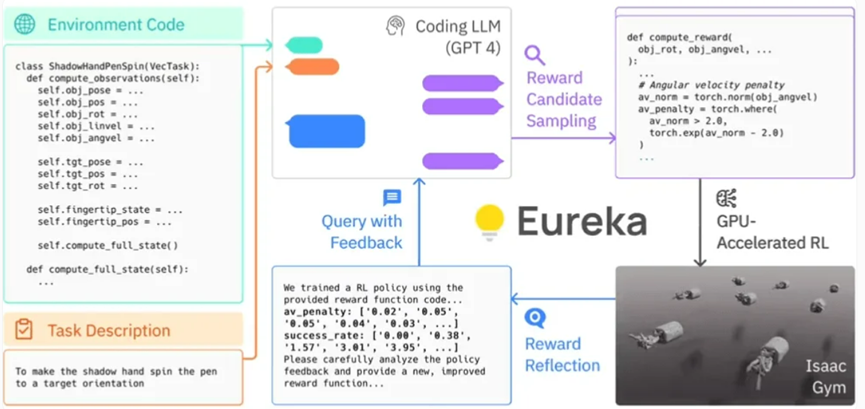
Eureka’s framework
The researchers also found that the more complex the task, the more GPT- 4's instructions are better than the human instructions of the so-called "reward engineers". Researchers involved in the study even called Eureka a "superhuman reward engineer."
#Eureka successfully bridges the gap between high-level reasoning (encoding) and low-level motor control. It uses what is called a "hybrid gradient architecture": a pure inference black box LLM (Language Model) guides a learnable neural network. In this architecture, the outer loop runs GPT-4 to optimize the reward function (gradient-free), while the inner loop runs reinforcement learning to train the robot’s controller (gradient-based).
- Linxi "Jim" Fan, Senior Research Scientist, NVIDIA
Eureka can integrate human feedback to Better tailor rewards to more closely align with developer expectations. Nvidia calls this process "in-context RLHF" (contextual learning from human feedback)
It is worth noting that Nvidia's research team has open sourced Eureka's AI algorithm library . This will allow individuals and institutions to explore and experiment with these algorithms through Nvidia Isaac Gym. Isaac Gym is built on the Nvidia Omniverse platform, a development framework for creating 3D tools and applications based on the Open USD framework.
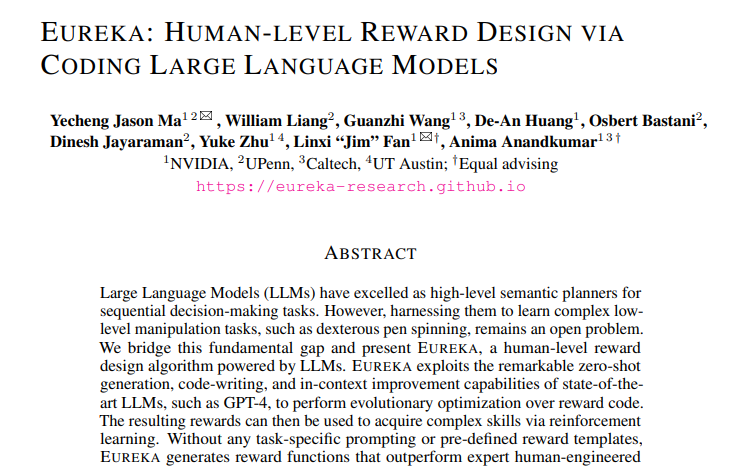
- Paper link: https://arxiv.org/pdf/2310.12931.pdf
- Project link: https://eureka-research.github.io/
- Code Link: https://github.com/eureka-research/Eureka
How to evaluate?
Over the past decade, reinforcement learning has achieved great success, but we must acknowledge that there are still ongoing challenges. Although there have been attempts to introduce similar technologies before, compared with L2R (Learning to Reward) which uses language models (LLM) to assist reward design, Eureka is more prominent because it eliminates the need for task-specific prompts. What makes Eureka better than L2R is its ability to create freely expressed reward algorithms and leverage environmental source code as background information.
NVIDIA’s research team conducted a survey to explore whether priming with a human reward function offers some advantages. The purpose of the experiment is to see if you can successfully replace the original human reward function with the output of the initial Eureka iteration.
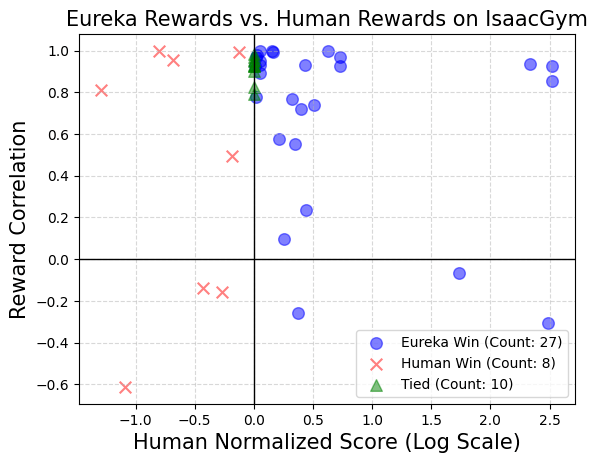
In the test, NVIDIA’s research team used the same reinforcement learning algorithm and the same hyperparameters for all tasks in the context of each task. The final reward function is optimized. To test whether these task-specific hyperparameters are well-tuned to ensure the effectiveness of artificially designed rewards, they employed a well-tuned proximal policy optimization (PPO) implementation that was based on previous work without any modifications. For each reward, the researchers conducted five independent PPO training runs and reported the average of the maximum task metric values reached at policy checkpoints as a measure of reward performance.
The results show that human designers often have a good understanding of relevant state variables, but may lack certain proficiency in designing effective rewards.
This groundbreaking research from Nvidia opens new frontiers in reinforcement learning and reward design. Their universal reward design algorithm, Eureka, harnesses the power of large language models and contextual evolutionary search to generate human-level rewards across a broad range of robotic task domains without the need for task-specific prompts or human intervention, significantly changing our Understanding of AI and machine learning.
The above is the detailed content of The robot learned to spin pens and plate walnuts! GPT-4 blessing, the more complex the task, the better the performance. For more information, please follow other related articles on the PHP Chinese website!

Hot AI Tools

Undresser.AI Undress
AI-powered app for creating realistic nude photos

AI Clothes Remover
Online AI tool for removing clothes from photos.

Undress AI Tool
Undress images for free

Clothoff.io
AI clothes remover

AI Hentai Generator
Generate AI Hentai for free.

Hot Article

Hot Tools

Notepad++7.3.1
Easy-to-use and free code editor

SublimeText3 Chinese version
Chinese version, very easy to use

Zend Studio 13.0.1
Powerful PHP integrated development environment

Dreamweaver CS6
Visual web development tools

SublimeText3 Mac version
God-level code editing software (SublimeText3)

Hot Topics
 1359
1359
 52
52
 Bytedance Cutting launches SVIP super membership: 499 yuan for continuous annual subscription, providing a variety of AI functions
Jun 28, 2024 am 03:51 AM
Bytedance Cutting launches SVIP super membership: 499 yuan for continuous annual subscription, providing a variety of AI functions
Jun 28, 2024 am 03:51 AM
This site reported on June 27 that Jianying is a video editing software developed by FaceMeng Technology, a subsidiary of ByteDance. It relies on the Douyin platform and basically produces short video content for users of the platform. It is compatible with iOS, Android, and Windows. , MacOS and other operating systems. Jianying officially announced the upgrade of its membership system and launched a new SVIP, which includes a variety of AI black technologies, such as intelligent translation, intelligent highlighting, intelligent packaging, digital human synthesis, etc. In terms of price, the monthly fee for clipping SVIP is 79 yuan, the annual fee is 599 yuan (note on this site: equivalent to 49.9 yuan per month), the continuous monthly subscription is 59 yuan per month, and the continuous annual subscription is 499 yuan per year (equivalent to 41.6 yuan per month) . In addition, the cut official also stated that in order to improve the user experience, those who have subscribed to the original VIP
 Context-augmented AI coding assistant using Rag and Sem-Rag
Jun 10, 2024 am 11:08 AM
Context-augmented AI coding assistant using Rag and Sem-Rag
Jun 10, 2024 am 11:08 AM
Improve developer productivity, efficiency, and accuracy by incorporating retrieval-enhanced generation and semantic memory into AI coding assistants. Translated from EnhancingAICodingAssistantswithContextUsingRAGandSEM-RAG, author JanakiramMSV. While basic AI programming assistants are naturally helpful, they often fail to provide the most relevant and correct code suggestions because they rely on a general understanding of the software language and the most common patterns of writing software. The code generated by these coding assistants is suitable for solving the problems they are responsible for solving, but often does not conform to the coding standards, conventions and styles of the individual teams. This often results in suggestions that need to be modified or refined in order for the code to be accepted into the application
 Seven Cool GenAI & LLM Technical Interview Questions
Jun 07, 2024 am 10:06 AM
Seven Cool GenAI & LLM Technical Interview Questions
Jun 07, 2024 am 10:06 AM
To learn more about AIGC, please visit: 51CTOAI.x Community https://www.51cto.com/aigc/Translator|Jingyan Reviewer|Chonglou is different from the traditional question bank that can be seen everywhere on the Internet. These questions It requires thinking outside the box. Large Language Models (LLMs) are increasingly important in the fields of data science, generative artificial intelligence (GenAI), and artificial intelligence. These complex algorithms enhance human skills and drive efficiency and innovation in many industries, becoming the key for companies to remain competitive. LLM has a wide range of applications. It can be used in fields such as natural language processing, text generation, speech recognition and recommendation systems. By learning from large amounts of data, LLM is able to generate text
 Can fine-tuning really allow LLM to learn new things: introducing new knowledge may make the model produce more hallucinations
Jun 11, 2024 pm 03:57 PM
Can fine-tuning really allow LLM to learn new things: introducing new knowledge may make the model produce more hallucinations
Jun 11, 2024 pm 03:57 PM
Large Language Models (LLMs) are trained on huge text databases, where they acquire large amounts of real-world knowledge. This knowledge is embedded into their parameters and can then be used when needed. The knowledge of these models is "reified" at the end of training. At the end of pre-training, the model actually stops learning. Align or fine-tune the model to learn how to leverage this knowledge and respond more naturally to user questions. But sometimes model knowledge is not enough, and although the model can access external content through RAG, it is considered beneficial to adapt the model to new domains through fine-tuning. This fine-tuning is performed using input from human annotators or other LLM creations, where the model encounters additional real-world knowledge and integrates it
 To provide a new scientific and complex question answering benchmark and evaluation system for large models, UNSW, Argonne, University of Chicago and other institutions jointly launched the SciQAG framework
Jul 25, 2024 am 06:42 AM
To provide a new scientific and complex question answering benchmark and evaluation system for large models, UNSW, Argonne, University of Chicago and other institutions jointly launched the SciQAG framework
Jul 25, 2024 am 06:42 AM
Editor |ScienceAI Question Answering (QA) data set plays a vital role in promoting natural language processing (NLP) research. High-quality QA data sets can not only be used to fine-tune models, but also effectively evaluate the capabilities of large language models (LLM), especially the ability to understand and reason about scientific knowledge. Although there are currently many scientific QA data sets covering medicine, chemistry, biology and other fields, these data sets still have some shortcomings. First, the data form is relatively simple, most of which are multiple-choice questions. They are easy to evaluate, but limit the model's answer selection range and cannot fully test the model's ability to answer scientific questions. In contrast, open-ended Q&A
 Five schools of machine learning you don't know about
Jun 05, 2024 pm 08:51 PM
Five schools of machine learning you don't know about
Jun 05, 2024 pm 08:51 PM
Machine learning is an important branch of artificial intelligence that gives computers the ability to learn from data and improve their capabilities without being explicitly programmed. Machine learning has a wide range of applications in various fields, from image recognition and natural language processing to recommendation systems and fraud detection, and it is changing the way we live. There are many different methods and theories in the field of machine learning, among which the five most influential methods are called the "Five Schools of Machine Learning". The five major schools are the symbolic school, the connectionist school, the evolutionary school, the Bayesian school and the analogy school. 1. Symbolism, also known as symbolism, emphasizes the use of symbols for logical reasoning and expression of knowledge. This school of thought believes that learning is a process of reverse deduction, through existing
 SOTA performance, Xiamen multi-modal protein-ligand affinity prediction AI method, combines molecular surface information for the first time
Jul 17, 2024 pm 06:37 PM
SOTA performance, Xiamen multi-modal protein-ligand affinity prediction AI method, combines molecular surface information for the first time
Jul 17, 2024 pm 06:37 PM
Editor | KX In the field of drug research and development, accurately and effectively predicting the binding affinity of proteins and ligands is crucial for drug screening and optimization. However, current studies do not take into account the important role of molecular surface information in protein-ligand interactions. Based on this, researchers from Xiamen University proposed a novel multi-modal feature extraction (MFE) framework, which for the first time combines information on protein surface, 3D structure and sequence, and uses a cross-attention mechanism to compare different modalities. feature alignment. Experimental results demonstrate that this method achieves state-of-the-art performance in predicting protein-ligand binding affinities. Furthermore, ablation studies demonstrate the effectiveness and necessity of protein surface information and multimodal feature alignment within this framework. Related research begins with "S
 Laying out markets such as AI, GlobalFoundries acquires Tagore Technology's gallium nitride technology and related teams
Jul 15, 2024 pm 12:21 PM
Laying out markets such as AI, GlobalFoundries acquires Tagore Technology's gallium nitride technology and related teams
Jul 15, 2024 pm 12:21 PM
According to news from this website on July 5, GlobalFoundries issued a press release on July 1 this year, announcing the acquisition of Tagore Technology’s power gallium nitride (GaN) technology and intellectual property portfolio, hoping to expand its market share in automobiles and the Internet of Things. and artificial intelligence data center application areas to explore higher efficiency and better performance. As technologies such as generative AI continue to develop in the digital world, gallium nitride (GaN) has become a key solution for sustainable and efficient power management, especially in data centers. This website quoted the official announcement that during this acquisition, Tagore Technology’s engineering team will join GLOBALFOUNDRIES to further develop gallium nitride technology. G



